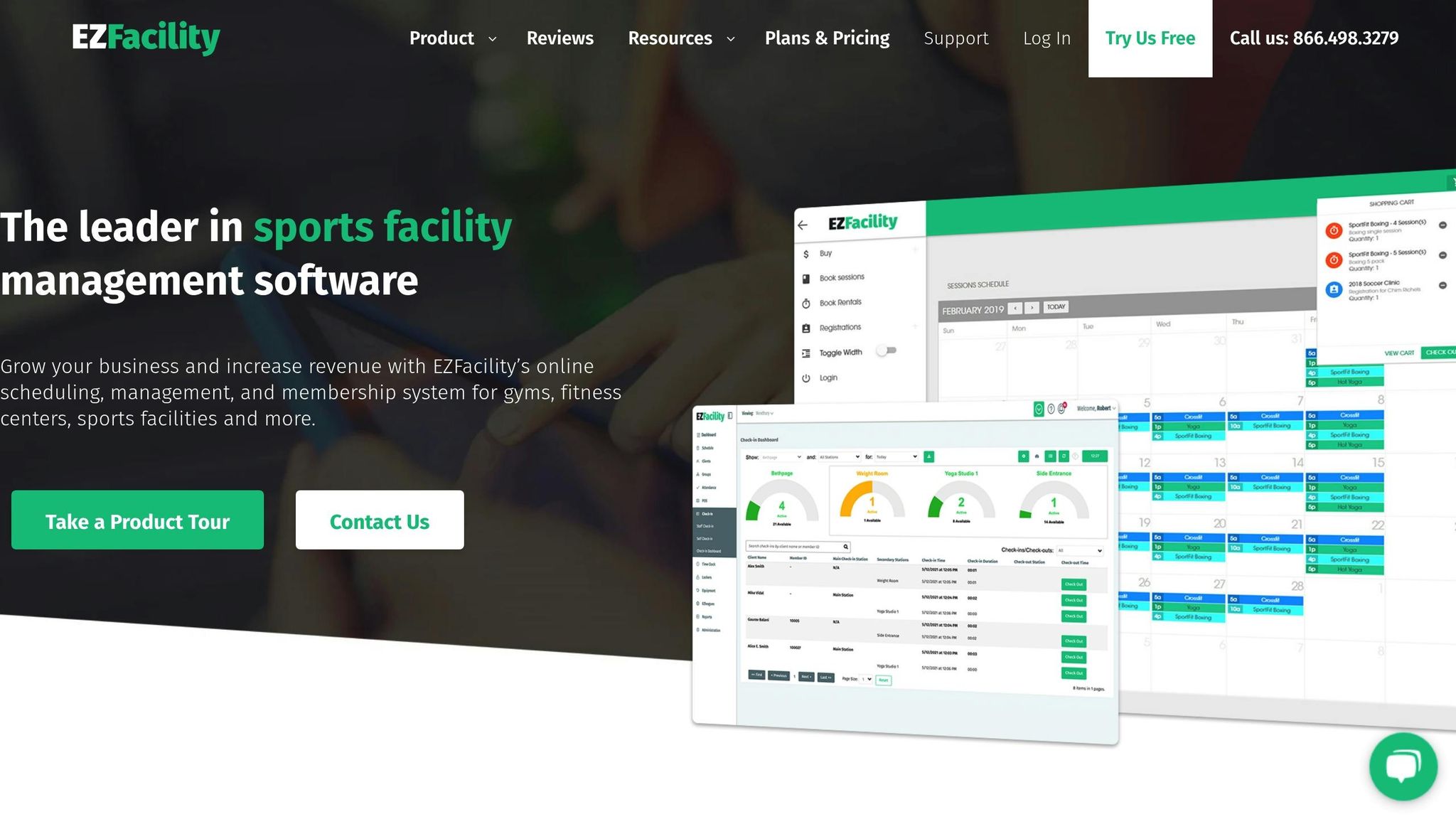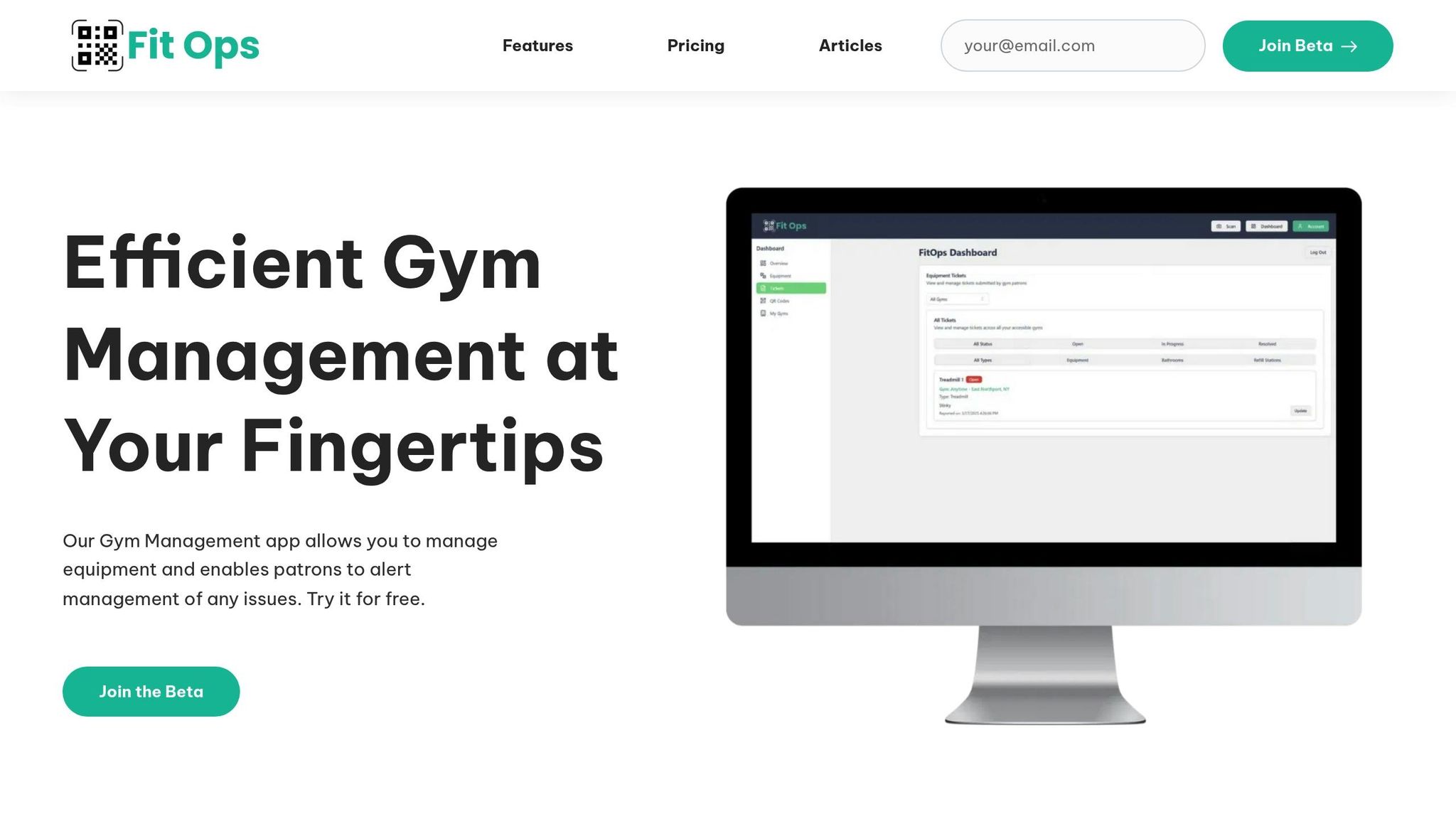Running a gym isn’t just about equipment and trainers - it’s about making things work smoothly. If your gym struggles with any of these 8 issues, it’s time to rethink how you manage operations:
- Slow Equipment Repairs: Broken machines take too long to fix, frustrating members and risking cancellations.
- Recurring Member Complaints: Overcrowding, cleanliness, and unavailability of equipment keep coming up.
- Staff Scheduling Confusion: Mixed-up schedules lead to missed classes, stressed staff, and unhappy members.
- Frequent Billing Errors: Payment mistakes hurt trust and waste resources fixing them.
- Unaddressed Safety Issues: Delayed fixes to hazards increase injury risks and liability.
- Lack of Data for Decisions: No clear metrics on member activity, revenue, or equipment usage.
- Poor Communication: Lost messages and missed updates frustrate staff and members alike.
- Disorganized Records: Scattered maintenance logs and safety reports make tracking impossible.
Why It Matters:
- 50% of members might cancel if expectations aren’t met.
- Poor management impacts retention rates, revenue, and member satisfaction.
Quick Fixes:
- Use digital tools for equipment reporting, scheduling, and billing.
- Track key metrics like revenue per member and equipment usage.
- Centralize communication and records for better organization.
Tip: Consider affordable gym management software like Fit Ops ($39/month per location) to streamline operations and keep members happy.
All-in-one Gym Management Software For Health Clubs | EZFacility

1. Equipment Repairs Take Too Long
Broken equipment hurts both your profits and your members' experience. When repairs are delayed, it leads to unhappy members and, ultimately, membership cancellations.
"Equipment downtime kills member experience. It disrupts workouts, reduces satisfaction, and damages your gym's reputation. Members expect smooth, functional machines every time they visit." - Dynamo Fitness
Delays in fixing equipment can also hit your wallet hard:
The Financial Costs
- Small problems can turn into major, expensive repairs.
- Membership cancellations often increase when equipment isn’t working.
- Poor maintenance raises the risk of liability issues.
Dave Pirri, Owner of Fit Service, puts it plainly: "Regularly scheduled maintenance keeps small issues from blooming into full-blown, expensive nuisances".
How to Minimize Downtime
To avoid extended periods of broken equipment, many gyms rely on these key strategies:
- Preventative Maintenance: Service machines after every 1,000 hours of use, prioritizing heavily used equipment like treadmills, bikes, and ellipticals.
- Daily Inspections: Train your team to check for loose parts, strange noises, or visible wear and tear.
- Digital Tracking: Use QR codes so staff can report issues instantly and stay updated on repair progress.
By following these practices, you can keep your equipment running smoothly and your members happy.
The Role of Digital Tools
Modern gyms are turning to digital solutions to streamline maintenance. These tools provide:
- Instant issue reporting via mobile devices
- Real-time updates on repair progress
- Automated schedules for regular maintenance
- Usage data to predict wear and tear
- A complete history of repairs for better planning
Using these tools ensures faster repairs and a better experience for your members.
2. Members Keep Filing the Same Complaints
When members repeatedly voice the same frustrations, it highlights gaps in how a gym is managed. Recent industry data shows that certain complaints consistently rank high, pointing to deeper issues that need attention.
Most Common Recurring Complaints
| Issue | Members Affected | Impact on Operations |
|---|---|---|
| Overcrowding | 45% | Harder to access equipment; overall workout quality drops |
| Equipment unavailability | 38% | Longer wait times; growing dissatisfaction |
| Cleanliness concerns | 32% | Health risks increase; gym's reputation takes a hit |
| Limited class schedules | 22% | Fewer attendees; potential revenue losses |
These recurring problems can erode your gym's reputation and hurt your bottom line if left unchecked.
"It takes 20 years to build a reputation and five minutes to ruin it. If you think about that, you'll do things differently."
Why Complaints Keep Recurring
The same complaints arise over and over for a few key reasons:
- Lack of tracking: Without proper documentation, issues are overlooked.
- Poor communication: Members feel ignored when feedback isn’t acknowledged.
- Temporary fixes: Quick patches don’t solve the root cause.
- Insufficient staff training: Employees struggle to handle problems effectively.
"Listening to your members' opinions, suggestions, and complaints can lead to valuable insights for improving your gym's services and overall experience."
Building a Better Resolution System
To stop the cycle of complaints, you need a structured approach:
- Offer multiple feedback channels: Make it easy for members to share concerns via mobile apps, suggestion boxes, or email.
- Respond quickly: Acknowledge complaints within 24-48 hours to show you take them seriously.
- Track everything: Use a system to log complaints and their resolutions.
- Analyze regularly: Monthly reviews can help spot patterns and recurring issues.
- Follow up: Check back with members to ensure they’re satisfied with the solution.
Modern tools can simplify this process by automatically logging complaints, tracking resolutions, and analyzing feedback trends. They can even prompt timely follow-ups, ensuring no issue goes unresolved.
3. Staff Schedules Are Often Mixed Up
Disorganized staff schedules can throw off class coverage, frustrate members, and lead to a chain reaction of operational headaches.
The Real Cost of Schedule Confusion
When schedules are poorly managed, the effects ripple through various areas:
| Area Affected | Operational Impact | Resulting Problem |
|---|---|---|
| Staff Coverage | Too few or too many staff | Lower service quality |
| Employee Morale | Higher stress levels | Increased turnover |
| Member Experience | Inconsistent class delivery | Lower satisfaction |
| Labor Costs | Inefficient staff allocation | Higher expenses |
Studies confirm that scheduling issues rank as a top reason for job dissatisfaction and staff turnover, especially in industries like fitness where consistent class schedules and trainer availability are critical.
Common Scheduling Pitfalls
Here are some of the most frequent scheduling problems:
- Double-booked instructors: Overlapping assignments create confusion and disrupt class flow.
- Insufficient rest periods: Not allowing the recommended 12-hour gap between shifts can lead to burnout.
- Poor communication: Staff left in the dark about schedule changes often feel unprepared.
- Manual errors: Paper or spreadsheet-based systems are prone to mistakes, increasing the risk of conflicts.
Scheduling stress also contributes to absenteeism. On average, 3% of full-time staff miss work due to burnout, further complicating staffing.
Building a Better Scheduling System
-
Establish Clear Time-Off Policies
Make it simple for employees to request and receive approval for time off. This reduces last-minute coverage issues and ensures fairness. -
Use Digital Scheduling Tools
Modern scheduling software can automatically flag conflicts, track availability, and send updates instantly. These tools minimize errors and improve communication. -
Maintain a Backup Roster
Keep a list of qualified substitutes ready to step in when needed. This ensures classes run smoothly even during unexpected absences. -
Regularly Review Schedules
Monitor scheduling trends to catch problems early. This allows you to adjust staffing and communicate changes effectively.
Just like managing equipment and gathering member feedback, having a structured scheduling system is essential for running a smooth operation.
4. Billing Mistakes Happen Too Often
Billing errors can hurt your gym just as much as equipment or scheduling problems. With the average American spending about $155 per month on fitness-related expenses, getting billing right is essential to keeping your members' trust and protecting your bottom line.
The Real Impact of Billing Errors
| Impact Area | Immediate Impact | Long-Term Consequence |
|---|---|---|
| Financial | Loss of revenue | Extra effort to recover debts |
| Member Trust | Frustration and complaints | Increased member cancellations |
| Staff Resources | Time spent fixing mistakes | Less focus on growth efforts |
Frequent billing mistakes don't just affect revenue - they also drain resources and harm member satisfaction.
Common Billing Issues
Billing problems often fall into these categories:
- Inconsistent Payment Collection: Incorrect charges or poorly timed billing cycles.
- Manual Entry Errors: Mistakes when entering payment details.
- Delayed Follow-ups: Late notices for overdue payments, causing confusion.
- Poor Communication: Unclear payment terms that lead to disputes.
These issues disrupt operations and can frustrate members, making a streamlined billing process essential.
"Payments and billing are vital for your gym's operations. It's crucial to ensure that your members consistently pay on time. Moreover, your financial reports and accounting must be accurate to guarantee profitability."
– Kelli Sweeting
Improving Your Billing System
Here’s how to minimize billing errors and keep your gym running smoothly:
- Simplify Payment Structures: Offer clear membership options and pricing terms.
- Automate Payments: Use recurring billing to ensure consistent collections.
- Establish Clear Communication Channels: Set up dedicated points of contact for billing inquiries.
- Conduct Regular Financial Reviews: Track payment trends and reconcile accounts frequently.
Modern gym management software with integrated billing features can automate many of these processes. This not only reduces errors but also frees up staff to focus on improving member experiences. While it requires an upfront investment, such software often pays for itself through better collection rates and lower administrative costs.
5. Safety Issues Don't Get Fixed Quickly
Leaving safety concerns unaddressed puts your gym at serious risk. Recent statistics are eye-opening: in 2021, exercise equipment caused 409,000 injuries, while sports and recreational equipment accounted for 3.2 million emergency room visits. Tackling safety issues quickly isn't just about protecting your members - it's also about reducing your liability.
The Cost of Ignoring Safety Problems
Delaying safety fixes can have immediate and long-term effects:
| Impact Area | Immediate Risk | Long-Term Consequence |
|---|---|---|
| Member Safety | Higher chances of injuries | Loss of trust among members |
| Legal Exposure | Liability for known hazards | Lawsuits and potential regulatory fines |
| Business Reputation | Negative feedback | Lower member retention and bad reviews |
Common Safety Concerns to Address
Safety issues often fall into these categories:
- Equipment Maintenance: Problems like frayed cables, loose bolts, or malfunctioning safety stops.
- Facility Conditions: Hazards such as slippery floors, dim lighting, or blocked emergency exits.
- Emergency Response: Outdated first aid kits or staff lacking proper training.
- Air Quality and Ventilation: Poor airflow or inadequate ventilation systems.
Addressing these issues quickly helps reduce risks and protect your gym's reputation.
How to Streamline Safety Management
Using a modern gym management system can make handling safety issues much easier. Look for features like:
- Mobile reporting for safety concerns, allowing instant updates.
- Automatic routing of issues to maintenance staff.
- Tools to track progress on repairs and resolutions.
- Digital logs to document incidents and solutions for accountability.
These tools can help you stay on top of safety and keep your gym running smoothly.
sbb-itb-1efabb1
6. Missing Data for Key Business Decisions
Making decisions without solid data is like steering a ship without a compass. Businesses that rely on data see 2.6 times higher ROI compared to those that don't, especially when it comes to client analytics.
The True Cost of Operating Without Data
Without access to key metrics, gyms miss out on critical insights like revenue per member, engagement duration, operating costs, and equipment usage. These numbers are essential for maintaining profitability:
| Metric | Target | Impact of Missing Data |
|---|---|---|
| Average Revenue Per Member | $205 | Harder to adjust pricing and services |
| Length of Engagement | 14 months | Missed opportunities to retain at-risk members |
| Operating Costs | 66% of revenue | Struggles with expense management |
| Equipment Utilization | Varies by time | Inefficient resource allocation |
Gyms that consistently analyze client data are 23 times more likely to attract new members.
Key Metrics You Should Be Tracking
Monitoring the right KPIs is essential for your gym's financial health. Focus on these critical metrics:
- Member Activity Patterns: Understand peak times and equipment usage to fine-tune scheduling.
- Financial Performance: Keep tabs on operating profit, expenses, and service ROI.
- Member Engagement: Track visit frequency and attendance in classes.
- Retention Metrics: Measure engagement length and identify members at risk of leaving.
Why Data-Driven Decisions Matter
Did you know that a single interaction can boost member visits by 20%? Modern gym management systems make it easier to:
- Monitor equipment usage to avoid overcrowding.
- Analyze attendance trends to improve class schedules.
- Spot low-engagement members early to reduce cancellations.
- Measure marketing campaign ROI to refine strategies.
Using data doesn’t just help identify problem areas - it also guides better communication and scheduling improvements.
"By basing decisions on sound gym metrics, owners greatly increase their chances of avoiding costly errors, reaching profitability sooner and sustaining solid profit margins long term." - Two-Brain Business
Up next, we'll explore how internal communication might be affecting your gym's operations.
7. Messages Often Get Lost or Mixed Up
Poor communication can cost gyms thousands of dollars due to lost productivity and errors, leading to operational headaches.
The Real Cost of Miscommunication
When communication breaks down, it impacts several critical areas:
| Area | Impact | Common Issues |
|---|---|---|
| Member Experience | Lower satisfaction | Missed class updates, billing confusion |
| Staff Efficiency | Reduced productivity | Schedule conflicts, unclear assignments |
| Revenue | Increased costs | Member churn, redundant work |
| Safety | Higher risk | Delayed maintenance notifications |
Did you know it’s five times more expensive to attract a new member than to keep an existing one? Miscommunication can push up to 50% of members to quit within their first year. These numbers highlight the need for a streamlined and centralized communication system.
Common Warning Signs
- Missed Appointments: Members show up for canceled classes because they weren’t informed.
- Conflicting Information: Staff members give contradictory details about policies or schedules.
- Delayed Responses: Member inquiries go unanswered, leading to frustration.
- Redundant Work: Multiple staff members handle the same task due to unclear instructions.
Why Centralized Communication Matters
Modern gym management systems can simplify communication by offering tools like:
- Automated Reminders: Automatically send updates for class schedules, membership renewals, and maintenance work.
- Multi-Channel Messaging: Reach members through email, SMS, or push notifications.
- Message Tracking: Confirm that important updates are delivered and read.
- Segmented Messaging: Target specific groups with tailored updates.
"Communication and member retention go hand-in-hand. Good communication is at the core of a well-operated fitness business. You need a strong communication plan to nurture happy and motivated members."
– Jenny Weller, Fitness Business Writer
Tips for Better Communication
- Create clear communication protocols for your team.
- Use automated tools to handle routine updates.
- Regularly gather and act on member feedback.
- Keep messaging consistent across all platforms.
- Document key conversations and decisions to avoid confusion.
8. Required Records Are Hard to Find
Keeping gym records disorganized can lead to serious problems. Accurate records are key to avoiding compliance headaches and making smart management decisions. But when maintenance logs, safety reports, and equipment records are scattered across paper files, spreadsheets, and various digital tools, it becomes nearly impossible to track and access the information you need.
The Hidden Costs of Poor Record Management
| Impact Area | Consequences | Business Risk |
|---|---|---|
| Safety Compliance | Missed equipment inspections | Legal liability |
| Asset Management | Delayed maintenance | Equipment failure |
| Operations | Redundant work | Increased costs |
| Decision Making | Incomplete data | Poor planning |
Gyms often deal with thousands of pieces of equipment that need to work reliably. Without proper documentation, keeping track of maintenance history and planning repairs becomes a guessing game.
Common Record-Keeping Challenges
- Scattered Information: Staff waste valuable time searching for fragmented records.
- Delayed Updates: Paper systems lead to late updates, creating maintenance gaps.
- Incomplete Documentation: Missing safety checks and repair records increase liability risks.
- Limited Accessibility: Physical records are often unavailable during emergencies or off-hours.
These issues highlight the need for a more organized, digital approach to record management.
Digital Solutions for Better Record Management
Modern digital tools can simplify record-keeping and solve these problems:
- Real-Time Updates: Maintenance logs are updated instantly as tasks are completed.
- Automated Tracking: Alerts and reminders help ensure timely maintenance and certifications.
- Centralized Storage: All records are stored in one place, making them easy to search and access.
Best Practices for Digital Record-Keeping
Switching to digital systems can feel daunting, but following these best practices can make the transition smoother:
- Standardize Documentation: Use consistent formats for logs and safety records.
- Enable Mobile Updates: Equip staff with tools to update records on the go.
- Implement Data Validation: Require all necessary fields to be completed.
- Conduct Regular Audits: Check records periodically for accuracy and completeness.
- Maintain Backup Systems: Protect data with secure and reliable backups.
Adopting these strategies not only streamlines gym operations but also strengthens safety measures, ensuring everything runs more efficiently.
Fit Ops Gym Management Software Solutions

Fit Ops Gym Management Software addresses common challenges in gym operations with solutions designed to improve efficiency. Here’s a breakdown of its key features, which help manage equipment, maintenance, and data more effectively.
Smart Equipment Management
Keeping track of gym equipment is critical for smooth operations. Fit Ops uses a QR code system to simplify this process:
| Feature | How It Helps | Why It Matters |
|---|---|---|
| QR Code Tagging | Quickly identifies equipment | Speeds up repair response time |
| Mobile Reporting | Allows one-tap issue reports | Reduces equipment downtime |
| Real-time Alerts | Notifies staff immediately | Ensures faster maintenance |
| Usage Analytics | Tracks equipment usage | Improves maintenance planning |
Simplified Maintenance Workflow
Fit Ops makes maintenance easier with a mobile-friendly system. When a gym member scans a QR code to report an issue, the software automatically creates a maintenance ticket. It then notifies staff, tracks the repair status in real time, and logs the maintenance history for future reference.
Data-Driven Insights
The platform provides analytics to help gym owners make smarter decisions. It tracks key performance metrics such as:
- Equipment usage trends
- Maintenance frequency
- Member feedback patterns
These insights allow gyms to identify problem areas and optimize their operations.
Affordable Pricing
Fit Ops offers its services for $39 per location per month. This includes:
- Unlimited equipment tracking
- Unlimited user accounts
- Role-based access for multiple users
- A complete ticket tracking system
How to Get the Most Out of Fit Ops
To fully benefit from Fit Ops, gyms should follow these steps:
- Tag All Equipment: Assign a unique QR code to every machine or item.
- Train Your Team: Ensure all staff members are familiar with the mobile interface.
- Set Clear Procedures: Establish guidelines for managing maintenance tickets.
- Review Analytics Regularly: Use data insights to fine-tune operations.
Next Steps: Fix Your Gym's Management Issues
Improve your gym's operations with these practical steps. Based on the issues highlighted earlier, it's time to take decisive action.
Start by evaluating your current systems and establishing a daily schedule for maintenance and cleaning.
Here’s what you can do:
- Digitize your records: Keep track of maintenance tasks, member feedback, and safety concerns in one place.
- Centralize your operations: Use a single system to manage schedules, maintenance requests, and updates for members.
- Leverage management software: Simplify scheduling, billing, and member communication with a dedicated platform.
Consider using Fit Ops Gym Management Software to streamline your operations. At just $39 per location per month, it offers solutions tailored to key areas:
| Operational Area | Solution Provided |
|---|---|
| Equipment Management | QR codes for quick issue reporting |
| Staff Coordination | Mobile-friendly tools for faster response times |
| Data Management | Real-time analytics and reporting |
| Member Communication | Easy-to-use feedback collection system |
Incorporate these tools into your workflow to see immediate improvements.
Make sure your team is trained on the new systems and set clear service expectations. Address critical issues without delay. The sooner you resolve these challenges, the better experience you'll provide for your members.
FAQs
How can gym management software help solve common member complaints?
Gym management software can effectively address common member complaints by streamlining operations and enhancing the overall member experience. Features like online class registration, automated booking confirmations, and efficient scheduling tools help minimize frustrations related to class availability and reservations.
Additionally, the software enables quick communication of schedule changes and allows staff to respond to concerns promptly. By simplifying processes and improving communication, gym management software helps create a more seamless and satisfying experience for members.
How can digital tools for staff scheduling enhance gym operations?
Using digital tools for staff scheduling can significantly improve gym operations by simplifying and streamlining the process. These tools make it easy to manage staff availability, class schedules, and last-minute changes, ensuring your gym runs efficiently. Instructors can quickly access their schedules and class rosters on mobile devices, reducing miscommunication and saving time.
Additionally, digital scheduling systems help align staff shifts with gym demand, avoiding overstaffing or understaffing during peak hours. Many tools also integrate with payroll systems, automating time tracking and payroll calculations, which minimizes errors and administrative tasks. By adopting these tools, gym owners can enhance operational efficiency and create a better experience for both staff and members.
Why is having a centralized system for communication and record-keeping important for gyms, and how does it improve member satisfaction?
A centralized system for communication and record-keeping is crucial for gyms because it ensures smooth operations and a better experience for members. By consolidating schedules, bookings, and member information in one place, staff can provide consistent and accurate service. This reduces errors, avoids scheduling conflicts, and ensures everyone is on the same page.
For members, this translates to shorter wait times, faster responses to questions, and a more seamless experience overall. When operations run efficiently, members feel valued and are more likely to stay loyal to your gym.


